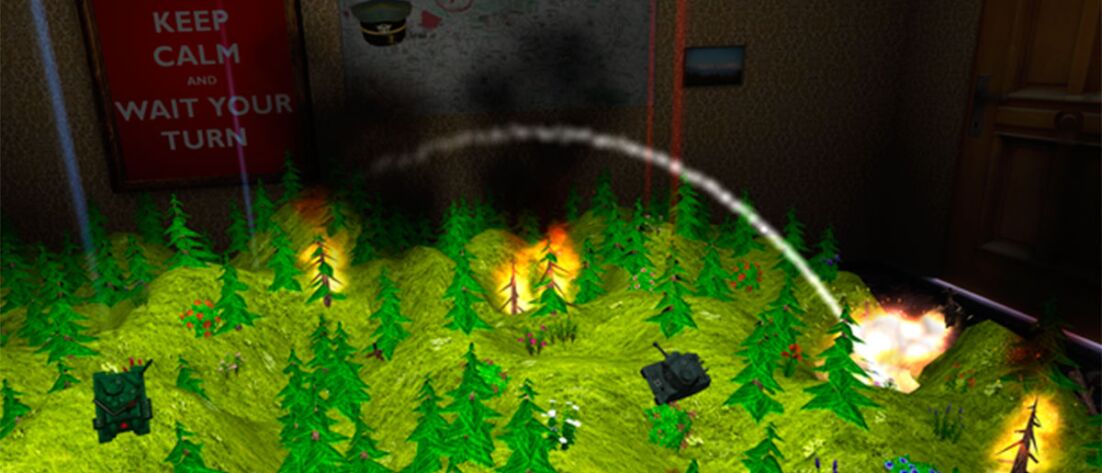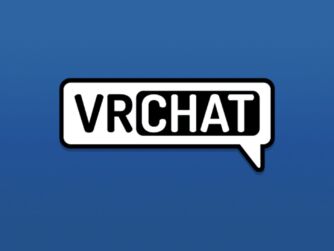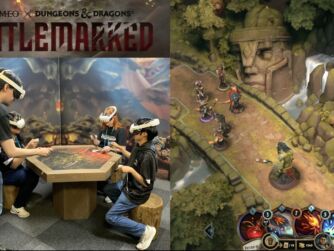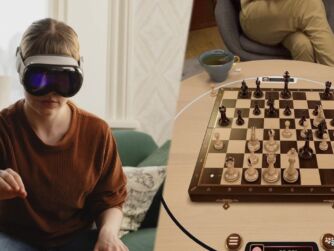Daniel “SvenViking” Fearon is a developer behind the Scorched Battalion turn-based artillery game, which won the Silver prize for the Oculus Mobile Game Jam. Daniel talks about some of the design principles between alternating between first and third-person perspectives, and the evolution of that project. He also talks about his path into becoming a VR developer starting from getting into VR because it might help with his neck injury to then spending too much time having a text-to-speech program read him the posts on the oculus subreddit. He’s now developing a full version of Scorched Battalion in collaboration with his brothers, and he recommend’s Vernor Vinge’s Rainbows End as a sci-fi book that points towards where this is all headed.
LISTEN TO THE VOICES OF VR PODCAST
Become a Patron! Support The Voices of VR Podcast Patreon
Theme music: “Fatality” by Tigoolio
Subscribe to the Voices of VR podcast.
Rough Transcript
[00:00:05.412] Kent Bye: The Voices of VR Podcast.
[00:00:12.162] Daniel Fearon: I'm Daniel Ferron, known as Sven Viking on Reddit. I also worked on the Sven Co-op mod. While I have been interested in virtual reality for some time, I've been since handing in candy wrappers to get a try on the Dactyl Nightmare in New Zealand. But I've been having some problems with my neck actually. It's sitting at the computer for extended periods, which is causing me some trouble with that and I got partly interested in VR again because I was hoping that something where you weren't having to sit still and look in the same direction all the time would actually allow me to work more effectively for longer periods of time. But then when the VR Jam, more recently the mobile VR Jam came around, I'd been wanting to develop something for quite some time. I just thought I had to try going in for it, even though I thought I had no chance to finish anything. I mean, sitting there for 20 minutes was getting to be too much. But partly through probably overdosing on anti-inflammatories. Somehow and also through another regime of physiotherapy I was able to actually complete something for that and we did win the silver which was unexpected and just an honour. and now we've been invited to Oculus Connect here. We're hoping to, of course now it's not just me that's making the game, it's also my two brothers, Nathaniel and Matthew. Nathan has done the 3D artwork and a lot of the minor things that actually take all the time and work, and Matthew did writing and scripting for the conversations. But we're hoping now to especially with what we learned from Oculus Connect 2 to complete a full game and release that on the Oculus Store.
[00:02:11.594] Kent Bye: Yeah, so maybe tell me a bit more about the mechanics of your game and kind of the unique mixture of tabletop mixed with first-person perspective and what is actually happening in your game.
[00:02:22.502] Daniel Fearon: Well, the gameplay is in many ways sort of the classic artillery turn-based game like Scorched Earth or Scorched Tanks on the Amiga. Or worms is a more modern example, but slightly less turn-based, sort of. But anyway, you're sitting at a table and there's sort of like a landscape that you would see maybe in wargaming. I was sort of inspired by the very beautiful little landscapes that some of the wargamers make that are just incredible. So I want just something a bit like that, you're sitting at that, but the little units are live and perform little acts in front of your eyes. So the gameplay, as I say, you're taking turns firing shots, trying to get your angles and your power right to drop the shots on the enemies, but then you have a lot of different weapons to mix things up. One of the differences, well okay there's the difference of it being in 3D obviously it's not entirely new but in VR it's new. Being in 3D does make a difference to the gameplay but also we've got two tanks per side that fire and I mean you set up shots for both tanks and fire at the same time. So there's a couple of strategic choices there because, I mean, if the first shot hits somebody that's going to mess up their shot, so you can try to guess at who the enemy is going to be targeting and give them a shield or something, or try to hit the enemy that you think is going to be firing the more powerful weapon, mess up his aim. But we also bring in a few surprises that I don't want to spoil here, but we try to surprise the player in a few different ways to change the gameplay, sort of overturn the whole system.
[00:04:14.715] Kent Bye: Yeah, there seems to be a strong component of the story that's a part of, you know, as it begins, you have kind of some dialogue. So maybe talk about, like, what you were trying to achieve there with kind of the more narrative components of the beginning of this game, kind of setting the context.
[00:04:28.626] Daniel Fearon: What we wanted to do there was, well, for one thing, just introduce humor into the game, which works in a couple of different ways. It helps to make people excuse some of their faults, for one thing. I mean, if it's a joke, you can get away with not being realistic, for example. but also we wanted just the different tanks to be specific characters so you could easily distinguish between the tanks. But what, when actually my brother suggested to me to use full voice acting, originally we had been intending to use text like dialogue boxes that popped up. The advantage to using voice acting was also that we could keep all the UI in world. So I mean we do have beams of light going about but we don't have any sort of thing stuck to your screen like a HUD. but I just didn't think it would be possible to actually get the voice acting done in time. But we managed to find voice actors who were just far above what I would have expected to be able to source. I'm really impressed by the voice work the voice actors actually submitted. But anyway, it does really add a lot more character to have the characters all speaking in their own unique voices, and we use locational audio too, so you can pick out who's speaking with a little bit of a particle effect to just make it obvious.
[00:05:56.805] Kent Bye: I'm curious about the decision that you made to kind of make this tabletop mixed with the first person perspective. I think that that near field VR has this certain compelling, interesting looking effects that can happen when you have that scale of the tabletop. So maybe talk about your process of kind of playing around with that.
[00:06:15.840] Daniel Fearon: Yeah, that was the idea from the beginning in fact. What it is is partly, or like Gabe Newell said, just that watching tiny things in VR, tiny people or anything, is just fun. But if you can then transport yourself to the perspective of the basically toy tanks sort of thing. It was just a lot of fun to look down on the little things, doing little stuff, and then you're, it's like you are one of them, and you see it all from a new perspective. Also, just as a practical thing, on the Gear VR, we wanted it to be playable with the touchpad only, so there was some, I mean, let's say you had to put in figures for your angle of rotation, just would be really awkward. Switching to first person to aim the shots made that a lot easier that you could just look and tap,
[00:07:03.266] Kent Bye: Yeah, I think that's a mechanic that's very unique to VR, to be able to go from that large scale and then kind of be immersed into the first-person perspective. And so, yeah, it's just something that you wouldn't be able to do in any other medium to kind of see that large picture, which, with all the hills and everything, it turns out that there's quite a bit of a strategy in terms of placing the tank, but also knowing where the target is, because once you go from first-person, you have no idea where they actually are. When I played it, I had no chance of actually hitting anything at all. But I'm curious from your perspective, as the creator of this game, if you're able to match that perspective of the global perspective and then merging down into the first-person perspective and then be able to translate that terrain in your mind enough to be able to shoot the shot and actually hit the target.
[00:07:48.533] Daniel Fearon: Well, to a fair extent, yes, but admittedly, the gameplay in this game is to be able to hit the target. I mean, if you could hit the target every time, you would always win. So, I know that that can be... We are intending to make it easier to pick up in the full version. With the VR Jam, we, of course, had to keep it very short, so we couldn't spend a lot of time introducing things.
[00:08:12.636] Kent Bye: And so you're also an active member of the Oculus subreddit, so maybe you could talk a bit about your participation in that community and what you try to do there.
[00:08:20.780] Daniel Fearon: I don't... I mean, I suppose I try to help when I can, but I'm not really trying anything there, I just spend too much time there, I just... partly when my neck problems were at worst. I didn't have a lot to do, and I just ended up reading that on my phone. Often I had the text-to-speech engine on the iPhone just read the post to me, and I ended up spending far too much time there. Later on, actually, Upload VR offered me a writing position, and that was actually what started me developing again. I was considering that and then I just thought about how much I missed actually making something and just wanted to try it even if it was not very easy.
[00:09:11.866] Kent Bye: Great.
[00:09:13.086] Daniel Fearon: So, what's next for you? Well, we're learning things that connect. I've been prescribed some new medication. My neck seems to be doing a lot better lately. and we want to complete the game and release it on the Gear VR on the Oculus Store and later on the Rift as well as a complete product and I don't know we may end up first releasing a version you know just something that we can actually complete in a reasonable time but we want to eventually have online multiplayer and boss fights and you know a lot of a lot of very interesting features that we don't want to spoil really.
[00:09:51.777] Kent Bye: Awesome. And finally, what do you see as kind of the ultimate potential of virtual reality and what it might be able to enable?
[00:10:00.419] Daniel Fearon: It's a large question, but I suppose if you wanted to, well, it's more augmented reality, but if you want to look at the works of Verna Vinci, like Rainbows End, I think that would give you a reasonable idea of the types of things that might be possible.
[00:10:17.982] Kent Bye: Can you expand on that a little bit? What kind of work they've done and what that means to you?
[00:10:21.963] Daniel Fearon: Well, obviously you're going to get sort of a combination of, I mean, you're going to get augmented reality and virtual reality as two separate things, maybe even using the same hardware eventually, but it's just such a big question. I'm going to end up sounding like the normal thing with a surgery simulation and people travelling to sports games or any sort of group event that normally you'd have a limited audience for but now anybody could. You know, you could have an infinite audience watching anything. Or you see the streaming, I never fully understood. I'm probably too old to fully understand the door of streaming. But now you could actually be in the same room with the streamers. You know, like they're sitting beside them on the couch watching them play a game. It sounds just a lot more compelling to me.
[00:11:17.885] Kent Bye: Okay, great.
[00:11:18.626] Daniel Fearon: Well, thank you. Thanks very much.
[00:11:21.262] Kent Bye: And thank you for listening! If you'd like to support the Voices of VR podcast, then please consider becoming a patron at patreon.com slash voicesofvr.




